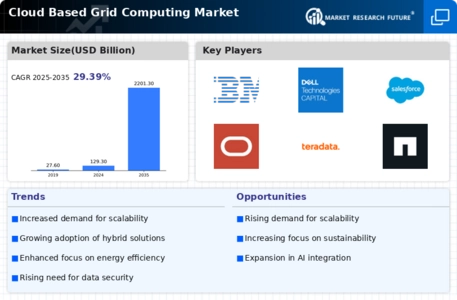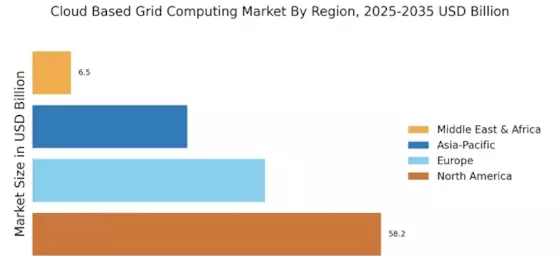Rising Demand for Scalable Solutions
The Cloud Based Grid Computing Market is experiencing a notable surge in demand for scalable computing solutions. Organizations are increasingly seeking flexible infrastructure that can adapt to their evolving needs. This trend is driven by the necessity for businesses to manage fluctuating workloads efficiently. According to recent data, the market for cloud computing is projected to reach approximately 832 billion USD by 2025, indicating a robust growth trajectory. As enterprises recognize the advantages of grid computing in optimizing resource allocation, the adoption of these solutions is likely to accelerate. This demand for scalability is not only reshaping IT strategies but also influencing investment decisions across various sectors, thereby propelling the Cloud Based Grid Computing Market forward.
Cost Efficiency and Resource Optimization
Cost efficiency remains a pivotal driver in the Cloud Based Grid Computing Market. Organizations are increasingly drawn to cloud-based solutions due to their potential for significant cost savings. By leveraging grid computing, businesses can optimize resource utilization, reducing the need for extensive on-premises infrastructure. This shift is particularly relevant as companies aim to minimize operational expenses while maximizing performance. Data suggests that organizations can achieve up to 30% savings in IT costs by transitioning to cloud-based grid solutions. As financial prudence becomes paramount, the Cloud Based Grid Computing Market is likely to witness heightened interest from enterprises seeking to streamline their operations and enhance profitability.
Growing Need for Data Processing Capabilities
The Cloud Based Grid Computing Market is significantly influenced by the increasing need for advanced data processing capabilities. As data generation continues to escalate, organizations require robust solutions to analyze and process vast amounts of information efficiently. Grid computing offers a distributed approach that enhances processing power, enabling businesses to derive insights from their data more effectively. Recent statistics indicate that the global data sphere is expected to reach 175 zettabytes by 2025, underscoring the urgency for scalable data processing solutions. This growing demand for data analytics and processing is likely to drive investments in cloud-based grid computing, positioning the industry for substantial growth.
Increased Focus on Collaboration and Remote Work
The Cloud Based Grid Computing Market is witnessing a heightened focus on collaboration and remote work solutions. As organizations adapt to changing work environments, the need for collaborative tools that facilitate seamless communication and project management has become paramount. Cloud-based grid computing offers the infrastructure necessary to support distributed teams, enabling real-time collaboration on complex projects. This trend is reflected in the growing number of enterprises adopting cloud solutions to enhance productivity and streamline workflows. Data indicates that remote work is likely to remain a staple in many industries, further driving the demand for cloud-based grid computing solutions. This emphasis on collaboration is expected to shape the future landscape of the Cloud Based Grid Computing Market.
Integration of Artificial Intelligence and Machine Learning
The integration of artificial intelligence (AI) and machine learning (ML) technologies is emerging as a significant driver in the Cloud Based Grid Computing Market. Organizations are increasingly leveraging these advanced technologies to enhance their computational capabilities. AI and ML algorithms require substantial processing power, which grid computing can provide through its distributed architecture. This synergy not only improves efficiency but also enables organizations to tackle complex problems more effectively. As businesses seek to harness the power of AI and ML, the demand for cloud-based grid solutions is likely to rise. This trend suggests a transformative shift in how organizations approach data-driven decision-making, further propelling the Cloud Based Grid Computing Market.


















Leave a Comment